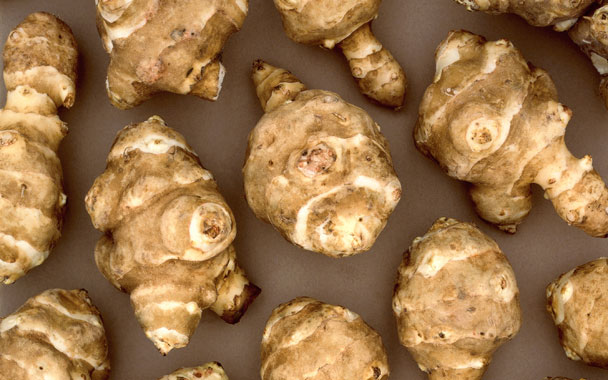Winter is a great time to cook, what with the long, cold nights and the miserable weather keeping you inside. It’s a shame there’s nothing to eat. Most farmers’ markets around the country have closed for the season, and what’s left in the ones that remain (we’re not talking about you, California) are animal products, apples, and miscellaneous roots. But the slim pickings can inspire you to look past the obvious–past the potatoes and carrots, for instance, to the Jerusalem artichokes.
Jerusalem artichokes aren’t artichokes, and they don’t come from the Middle East. What they are is the tuber produced by an enormous species of North American sunflower at the end of its life. (Rock-star farmer Richard de Wilde once took me to see his Jerusalem artichoke field in late September. The plants were nine feet tall and still hadn’t produced any tubers.) They’re kind of ugly, honestly—knobby and mishapen with papery brown skin. Persevere. They’re worth it.
Jerusalem artichokes are tasty uncooked, thoroughly cooked, and at every stage in between. Eaten raw they’re crunchy and a little sweet, like jicama with a deeper and more interesting flavor. They make a great salad, shredded or sliced super-thin on a mandoline, salted lightly, and tossed with sharp nut-oil vinaigrette. Or slice them somewhat thicker (a quarter-inch, say), sauté them with butter and shallots for just long enough to heat them through and take away any starchiness, and you’ll have a side dish that is what water chestnuts want to be when they grow up. Or cut them into chunks and add them to a pot of boiling potatoes when the latter are about half cooked. When they’re tender but not falling apart, drain and smash the two roots together and mix with bold amounts of salt and pepper and butter, cream, and milk to taste. You might think that nothing could be better than excellent mashed potatoes, but the lush truffle-y flavors of this purée will prove you wrong.
A couple of suggestions: I usually peel Jerusalem artichokes, but you can get away with a thorough washing if the skin is particularly thin. They will turn brown if you leave them out too long after slicing, so submerge them in water if you cut them up very long before you cook them. And finally, a disclosure: some people think Jerusalem artichokes can be a bit “windy,” in the euphemism of Simon Hopkinson, but I’ve never found that to be true.
Oh, about the name: One theory says that Jerusalem is a corruption of the Italian word for sunflower (girasole) and that the tubers taste a little like artichokes. They’re sometimes called sunchokes, and the French have the best name in the world: topinambour.




 Pinterest
Pinterest


